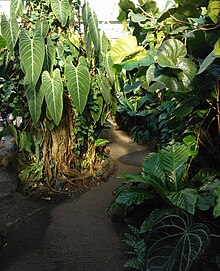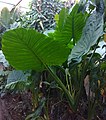| This article needs additional citations for verification. Please help improve this article by adding citations to reliable sources. Unsourced material may be challenged and removed. Find sources: "The Living Rainforest" – news · newspapers · books · scholar · JSTOR (July 2011) (Learn how and when to remove this message) |
| The Living Rainforest | |
|---|---|
 | |
| 51°28′52.69″N 1°13′14.79″W / 51.4813028°N 1.2207750°W / 51.4813028; -1.2207750 | |
| Date opened | 1993 |
| Location | Hampstead Norreys, Newbury, Berkshire, England |
| Land area | 1000 square metres |
| Annual visitors | 95,000 |
| Memberships | BIAZA, BGCI |
| Major exhibits | Amazon Aquarium, Armadillo, Bromeliads, Dwarf Caiman, Fischer's Turaco, Goeldi’s Monkeys, Orchids, Pygmy Marmosets, Snakes, Toucan, Small Islands, Sustainable Futures |
| Website | livingrainforest.org |
The Living Rainforest is an indoor greenhouse tropical rainforest located in Hampstead Norreys in Berkshire, England. It is an ecological centre, educational centre and visitor attraction consisting of three glasshouses, operated and run by the Trust for Sustainable Living. The glasshouses are named Amazonica, Lowlands and Small Islands respectively.
The Living Rainforest has been accredited by the Council for Learning Outside of the Classroom and awarded the LOtC Quality Badge. Each year around 25,000 children visit the Living Rainforest as part of their school's curriculum. It is open 7-days a week from 09:30 to 16:00.
History
The site was once an orchid nursery called Wyld Court Orchids who were well known for their collection of rare and beautiful natural orchid species, especially Cymbidiums and Lycastes. Wyld Court Orchids received considerable recognition from the R.H.S. including a distinction of Grand Champion Hybrid and Best in Show for a home-raised seedling at the British Orchid Council Congress Show. The privately owned ‘Wyld Court Rainforest’ was created in 1991 by philanthropist Keith Bromley (former chairman of the shoe retailer Russell and Bromley) and horticulturalist Barry Findon. Keith Bromley said he was inspired to create Wyld Court Rainforest after sailing in the Orinoco delta in Venezuela in the 1980s. It first opened to the public in April 1993 as a rainforest visitor centre. They donated the facility to the World Land Trust in 1996. On 30 June 2000, ownership of Wyld Court Rainforest Ltd transferred from the World Land Trust to a new company "The Living Rainforest", and has been operated by Karl Hansen as an independent educational charity since July 2000. The centre is home to over 700 plants and animals including rare and endangered species of global conservation value.
Attractions

The visitor attraction consists of three glasshouses that adjoin each other; the flora and fauna in each glasshouse are representative of different layers or areas of tropical rainforests. The rainforest layers represented in the Amazonica and Lowlands glasshouses include the canopy, understory and forest floor layers. The Small Islands glasshouse exhibits shows life at the edge of an island rainforest, the exhibits in this glasshouse are being developed to highlight the issues and concerns faced by Small Island Developing States (SIDS) throughout the world.
The Human Impact Building opened in 2006 incorporating sustainable materials, Low Embodied Energy, passive/natural ventilation, passive solar gain and a small photovoltaic solar array.
There is also a gift shop, café, outdoor adventure-themed children’s playground, and a picnic area with a rainforest theme.
Exhibits
- Dwarf Caiman exhibit completed July 2020, it is home to two male Dwarf Caiman
- Orchid Cloud Forest exhibit completed January 2020 featuring 100 orchid species and other plants from Central and South America
- Littoral Zone project completed in October 2018 saw the introduction of plants in Small Islands often found at or just above the high water mark, these together with the mangroves exhibit represent the Littoral Zone
- Bromeliads exhibit was introduced in August 2018, the concept of the exhibit is bromeliads growing on or around a fallen tree
- Toucan exhibit was rebuilt in July 2018, it is home to a Channel-billed toucan (Ramphastos vitellinus) and a male Azara’s Agouti (Dasyprocta azarae)
- Sustainable Futures exhibit was opened in January 2018, consists of interactive displays that include a look at Climate Drawdown
- Snakes exhibit was rebuilt in February 2017, it is home to – two Emerald Tree Boas (Corallus caninus), a Green Tree Python (Morelia viridis) and a Carpet Python (Morelia spilota)
- Small Islands exhibit was built in August 2016, it is home to a Green Iguana, mudskippers, various tropical fish and mangroves
- Armadillo exhibit was built in 2014, it is home to a Six-banded armadillo (Euphractus sexinctus)
- Goeldi's Monkeys exhibit was rebuilt and relocated in 2014, it is home to a troop of 5 Goeldi's monkeys (Callimico goeldii) and a male Azara's Agouti (Dasyprocta azarae)
- Fischer's Turacao exhibit was built in 2010 and is home to a pair of Fischer's Turacaos
Animals
- Asian Water Dragon
- Azara's agouti
- Blue poison dart frog
- Carpet Python
- Channel-billed toucan
- Dwarf Caiman
- Emerald Tree Boa
- Fischer's turaco
- Goeldi's Monkey
- Green Iguana
- Green Tree Python
- Home's hinge-back tortoise
- Linne's Two-toed Sloth
- Madagascar hissing cockroach
- Philippines Water Monitor
- Pygmy marmoset
- Roul Roul Partridge
- Six Banded Armadillo
- Yellow-knobbed curassow
- Ocellate river stingray
Plants
The Plant Collection at The Living Rainforest contains some of the most attractive species of the many tropical plant families such as bananas, bromeliads, calatheas, cinnamon, ficus, gingers, hoyas and orchids. However the highlights of the collection are the Aroids and the Philippine Jade Vine (seasonal). Plants of particular interest include;
- Anthurium clavigerum
- Anthurium crystallinum
- Anthurium magnificum
- Austrocylindropuntia subulata
- Black Anthurium
- Breadfruit
- Giant Fern
- Giant Taro
- Hoya bhutanica
- Jade Vine
- Myriocarpa stipitata
- King Anthurium
- Philodendron melanochrysum
- Philodendron melinonii
- Pitcher Plants
- Screw Pine
- Silk Floss Tree
- Travellers Palm
- Typhonodorum lindleyanum
- Cocoa tree
Gallery
-
 Amazonica Main Pond (North)
Amazonica Main Pond (North)
-
 Amazonica Main Pond (East)
Amazonica Main Pond (East)
-
 Acalypha hispida
Acalypha hispida
-
 Anthurium crystallinum
Anthurium crystallinum
-
 Anthurium regale
Anthurium regale
-
 Alocasia calidora
Alocasia calidora
-
 Bromeliad exhibit
Bromeliad exhibit
-
 Home's Hinge-Back Tortoise
Home's Hinge-Back Tortoise
-
 Jade Vine
Jade Vine
-
 Jade Vine
Jade Vine
-
 Yellow-knobbed Curassow
Yellow-knobbed Curassow
-
 Blue Morpho
Blue Morpho
-
 succulents in Small Islands
succulents in Small Islands
References
- "Trustees Report". Companies House. Retrieved 23 March 2019.
- "BIAZA Find a Zoo". biaza.org.uk. British and Irish Association of Zoos and Aquariums. Retrieved 9 February 2017.
- "BGCI Garden Search". bgci.org. Botanic Gardens Conservation International. Retrieved 8 February 2016.
- "Sustainable Futures". livingrainforest.org. The Living Rainforest. Retrieved 8 December 2018.
- "About The Trust". trustforsustainableliving.org. Trust for Sustainable Living. Retrieved 10 February 2019.
- "Learning Outside of the Classroom". Council for Learning Outside the Classroom. Retrieved 9 February 2019.
- "LOtC Quality Badge". Council for Learning Outside of the Classroom. Retrieved 9 February 2019.
- "Wyld Court Orchids". Quinta da Boa Vista Orchids. Retrieved 3 March 2019.
- "Our History |World Land Trust". newburytoday.co.uk. Retrieved 6 September 2016.
- "Our History |World Land Trust". worldlandtrust.org. Retrieved 25 September 2017.
- "Our History | The Living Rainforest". The Living Rainforest. Retrieved 14 April 2011.
- "Human Impact Building". The Living Rainforest. Retrieved 9 February 2019.
External links
 Media related to The Living Rainforest at Wikimedia Commons
Media related to The Living Rainforest at Wikimedia Commons- Official website
